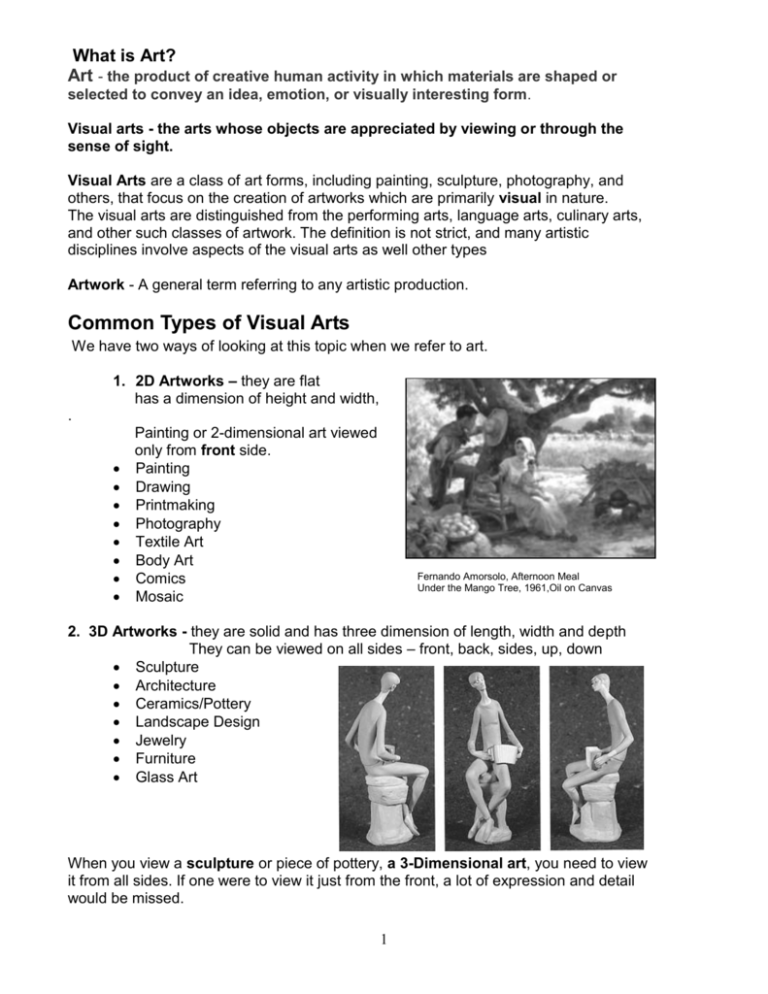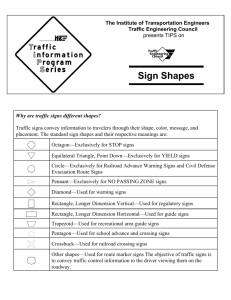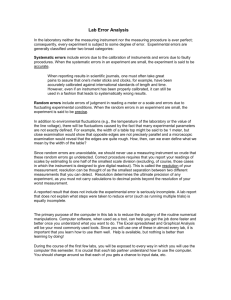1st qtr grade 3 handouts
advertisement

What is Art? Art - the product of creative human activity in which materials are shaped or selected to convey an idea, emotion, or visually interesting form. Visual arts - the arts whose objects are appreciated by viewing or through the sense of sight. Visual Arts are a class of art forms, including painting, sculpture, photography, and others, that focus on the creation of artworks which are primarily visual in nature. The visual arts are distinguished from the performing arts, language arts, culinary arts, and other such classes of artwork. The definition is not strict, and many artistic disciplines involve aspects of the visual arts as well other types Artwork - A general term referring to any artistic production. Common Types of Visual Arts We have two ways of looking at this topic when we refer to art. 1. 2D Artworks – they are flat has a dimension of height and width, . Painting or 2-dimensional art viewed only from front side. Painting Drawing Printmaking Photography Textile Art Body Art Comics Mosaic Fernando Amorsolo, Afternoon Meal Under the Mango Tree, 1961,Oil on Canvas 2. 3D Artworks - they are solid and has three dimension of length, width and depth They can be viewed on all sides – front, back, sides, up, down Sculpture Architecture Ceramics/Pottery Landscape Design Jewelry Furniture Glass Art When you view a sculpture or piece of pottery, a 3-Dimensional art, you need to view it from all sides. If one were to view it just from the front, a lot of expression and detail would be missed. 1 Dimension - A measure of spatial distance. Height - The first dimension, the measurement of the distance from the level of the lowest point to the level of the highest point of a shape or space. Width - The second dimension, after height. Width is usually the measurement of the extent of a shape or a space from side to side. Length - Usually refers to the longest dimension. Depth - The third dimension. The apparent distance from front to back or near to far in an artwork. When depth refers to an object's smallest dimension, then this distance can also be called its thickness. The Language of Art Art is a powerful language. Through it, artists communicate thoughts, ideas, and feelings. Like most languages, the language of art has its own special vocabulary. Unlike other vocabularies, however, the vocabulary of art is not made up of words. Rather, it is made up of visual elements. The visual elements include line, shape, form, texture, value color and space. The Elements of Art are the building blocks for a work of art. Artist use the elements planned and organized ways. They are organized according to the Principles of Design. Elements of Art - The basic components used by the artist when producing works of art. Those elements are color, value, line, shape, form, texture, and space. Line - A mark with length and direction(-s). An element of art which refers to the continuous mark made on some surface by a moving point. Kinds of Line 1. Curve line - a mark with length and direction that forms an irregular shape, or one that might be found in nature, rather than a regular, mechanical shape Such convex, concave, scroll, spiral and wavy lines Curve - A line or edge that deviates from straightness in a smooth, continuous way. The lines that arc through space Concave- having a surface or boundary that curves or bulges inward Concave Convex - having a surface or boundary that curves or bulges outward, as does the exterior of a sphere, or a balloon. Convex 2. Straight line - a mark with length and direction that is straight and forms a geometric shape Such as vertical, horizontal, diagonal lines Straight - Extending continuously in the same direction without curves or other deviations Vertical - The direction going straight up and down. Horizontal - Straight and flat across, parallel to the horizon. Diagonal - Having a slanted direction. Vertical 2 Horizontal Diagonal Shape - An element of art, it is an enclosed space defined and determined by other art elements such as line, color, value, and texture. Shape is an area enclosed by line, or seen as an area because of color or value changes. Shapes have 2-dimensions – the height and width. They appear to be flat. Kinds of Shape 1. Geometric Shapes – shapes that have smooth, even edges and angular corners. They are typically made with straight lines or shapes from geometry, including circle, ovals, triangles, rectangles and squares. Dimension of Shapes height width 2. Organic or Natural Shape – shapes found in nature such as trees, leaves, animals etc. Organic shapes are usually more rounded and appear most often in nature. 3 Kinds of Subjects 1. Landscape - A painting, photograph or other work of art which depicts scenery such as mountains, valleys, trees, rivers and forests. There is invariably some sky in the scene Cityscape - work of art which depicts scene from a city or urban scenery. Sunday Morning, Going to Town, Fernando Amorsolo, 1961 2. Portrait - A work of art that represents a specific person, a group of people, or an animal. Portraits usually show what a person looks like as well as revealing something about the subject's personality. Self-portrait -- A portrait an artist makes using himself or herself. Leonardo da Vinci (Italian, 1452-1519), Mona Lisa (La Joconde), c. 1503, oil on wood panel 3. Still Life or Still-life - A picture of inanimate objects. Common still life subjects include vessels, objects, furniture, books, clothing, settings, utensils, flowers, foods, etc., without obvious stories or important people Paul Cezanne (French) 1839-1906, The Basket Of Apples, Oil on Canvas Mahoning by Franz Kline 4 Roses & Lilacs, Raoul De Longpre









